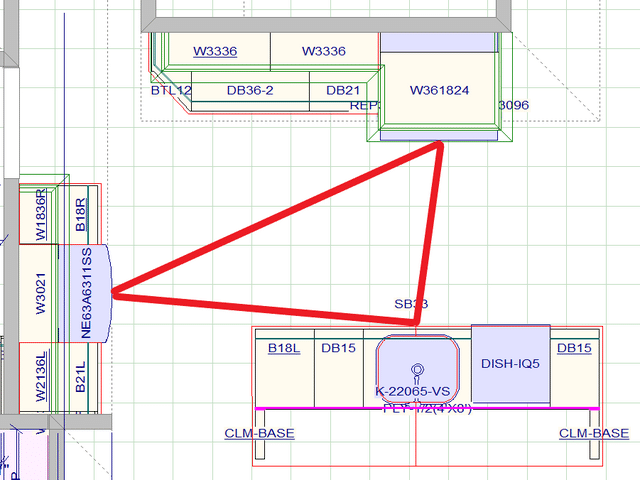What is the Kitchen Work Triangle?
The kitchen work triangle is a model used to determine the ideal placement of the refrigerator, sink and stove/cooktop. These three areas in the kitchen create lines of an imaginary triangle to show the closest path of travel. In a perfect kitchen, you want these three points close to each other but not cramped together.

The idea of the kitchen work triangle was originally presented in 1929 by Lillian Moller Gilbreth at a Women’s Expo and was initially called circular routing. It was developed to create the most efficient kitchen design and maximize the one-cook kitchen experience. By using time-motion studies, the following work triangle principles were established:
- The total of all three legs of the triangle should not exceed 26 feet
- One side of the triangle should not be less than 4 feet or more than 9 feet
- There should ideally be no major traffic interruptions in the triangle
- A pantry cabinet, double oven or other tall obstacles should not intersect any two points of the triangle
It is important to keep in mind that even though the work triangle is often regarded as the gold standard for kitchen design, it was developed for a one-cook kitchen. It is much more common in recent years for there to be multiple cooks in the kitchen and especially multiple at one time. In addition, kitchens are much larger than they were in 1929 when this idea was first presented. The overall increase in kitchen square footage affects the distance between each of the legs of the triangle and the total length of the work triangle. There are also more appliances utilized in today’s kitchens such as dishwashers, under counter refrigerators, microwaves and sometimes multiple sinks.
A kitchen work triangle is a traditional planning technique that can be applied when it is appropriate for your home. If you do have multiple cooks, it is more essential to think about work zones and traffic patterns. Creating separate zones such as preparation space, a cooking zone and a cleaning area will be a much better fit. The kitchen island typically becomes the focus of the kitchen when there is enough space for it. In many kitchens, the island becomes the central place for food prep, socialization and presentation.
When planning your remodel, be sure to share with your designer the amount of cooks, cooking habits and overall desired aesthetic to ensure your kitchen is personalized to your needs.
